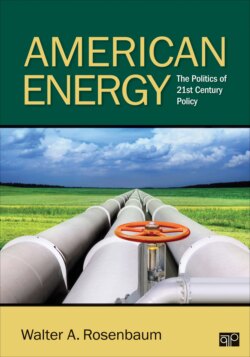Читать книгу American Energy - Walter A. Rosenbaum - Страница 16
На сайте Литреса книга снята с продажи.
The Constitution
ОглавлениеThe Constitution creates a master design for all US public policymaking. It is a document originally written by men deeply suspicious of a government armed with concentrated power and intended for a nation of farmers, shopkeepers, tradesmen, and merchants. What resulted was a government of countervailing forces with the power vested in each major institution limited by others and, in turn, limiting them.
This was not a government intended to “govern” energy production, or much else. The government that controls pollution and petroleum imports, licenses microwave ovens, regulates energy prices, fights oil spills, and oversees a thousand other programs now considered essential to energy management would have been unthinkable to the Framers. The Constitution has survived the enormous changes in American society and politics while preserving the political institutions it originally ordained. At the same time, the embedded cost is a continuing struggle to adapt constitutional institutions to the rapid and apparently accelerating pace of social, economic, and technological change nationally and globally.
Two of the Constitution’s fundamental principles for dividing and limiting power—the elaborate checks and balances within the federal government and the division of power between the federal government and the states—fragment policymaking authority, exacerbate conflict between governmental institutions, and slow the pace of innovation. This dispersion of power often encourages deliberation and sensibility to a wide range of interests in policy issues, but at the constant risk of delay, conservatism, and unpredictability in making and implementing policy.
Checks and balances. The Constitution, as Richard E. Neustadt reminds us, creates a government of separated institutions sharing power.15 This deliberate overlapping of authority, together with the Constitution’s vagueness in describing the nature of these powers and their proper division between governmental institutions, requires the institutions to collaborate if they are to govern and simultaneously incites rivalry between them. The checking and balancing of one institution by others, “ambition made to counteract ambition” in James Madison’s words, overlays all policymaking within the federal government.
Institutional collaboration and conflict are most readily apparent at the national level in the relationship between the presidency and Congress. The Constitution invests each institution with unique powers, but it also compels them to share authority in legislating, taxing, and spending; oversight of the executive branch; and many other policymaking activities. Thus, the president may be responsible for ensuring that the Minerals Management Service enforces safety regulations on Gulf of Mexico oil drilling, but Congress writes the law the MMS implements. Without such collaboration, policymaking would be virtually impossible. The president and Congress, however, are divided by responsibility to different electorates, by institutional rivalries, by competing party loyalties, and by a constitutional obligation to check each other. Congress itself is a house divided into partisan factions, one congressional faction always committed to the electoral defeat of the White House incumbent.
Federalism. The Constitution also divides the government “vertically,” granting some exclusively to Washington, some exclusively to the states, and some to be shared. This mixture of shared and separated authority encourages political rivalry as well as collaboration among the states and between the states and the federal government. Federalism gives a political form to state and regional interests, arms them with authority, and makes them influential participants in national policymaking. In the United States, policy is often the result of negotiation between a plurality of governmental entities—federal, regional, state, and local—whose distinctive interests are protected by federalism. One has only to observe the collaboration and collision between Washington and the Gulf States over management of the Deepwater explosion to confirm that federalism is alive and well today.
